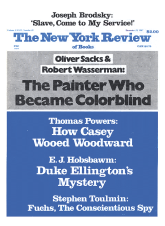Mr. Robertson had…a dramatic religious experience…. “I walked across a curtain to a whole new life,” he says now. “I understood why I was here, I understood my purpose, I even understood modern art.”
—The Wall Street Journal,
October 6, 1987
1.
Here is a young painter who may be said to represent the finest traditions of the University of London Graduate School Art Appreciation Program and the Christian Broadcasting Network School of Fine Arts, and if that is not word for word what it says on his resume provided by the Mary Boone Gallery, under whose caring aegis this show takes place, who are we to let a few minutiae distract us from the powerful statements in the other 99 percent of these colossal paintings?
For here is a young man whose controversial work cries out to us for understanding. Let us rise above his minor details, let us open our hearts to what he might be trying to tell us, let us see how even the titles of his paintings speak to us as in tongues on our own pain and life experiences. The Wildness of Oats. How Many Miles Is It to the Combat Zone? Now Another Distortion. Sharks in a Feeding Frenzy.
But my goodness gracious, how the supersophisticated have hounded him with their criticisms. How they look down their noses every time he traces something. Yes indeed, he has traced the figure of the front-line soldier in Combat Zone from a war comic. And I say to you, does the Lord Himself distinguish between the love that a man puts into tracing something faithfully to the way his Maker caused it to be made and the love that another man puts into drawing something from his own God-given imagination or rendering it freehand the way it appears to him in the light that the Almighty created on the First Day? Is not tracing just as much an act of commitment and obedience? For is not repetition equally, if not more so, an act of faith and humility? Amen. And did the Lord not make not only the soldier alive and in his foxhole but also the war comic and the very newsstand whereat the war comic is sold, and is it not just as much an example of the workings of Divine Grace if a man, also himself created by God, comes along and buys the war comic and then later casts it into the gutter, whereupon along comes this young David, with his eye on the same gutter, and singles out the war comic from amid the useless rubble of stones?
2.
It makes me ashamed, as David’s fellow man, to bring up the media’s cruel attack on these paintings, which are many feet high and wide, as nothing more than behemoth party invitations. Yes, there are surely parties in the art world, and at those parties there is liquor. Yes, a handful of people may say to themselves, “David is going to be at the party, so count me in, and the Devil take the hindmost!” But to conclude, as some have done, that this young man bears the burden of responsibility for all the liquor consumption in the art world, to say his true vocation is that of “liquor courier,” is an unfair calumny unless you can prove it.
Furthermore, let us pause and ask ourselves just why it is that we Americans expect our artists and their dealers, friends, and collectors to hold to a higher standard of morality than the rest of us.
3.
Now, there are other people who honestly and without hypocrisy raise a moral issue that is a little more legitimate. These people would look at this series of works called Nudes 19:12–29 and find it sinful to paint the figure of a woman naked, in all the many postures of temptation on a Colonial settee of the type that might be found in a Christian home, and then to apply washes of dark colors that make it hard to see the truth of Divinely created flesh—and not only that, but then to glue onto each canvas some household object so dreadful that it would not be tolerated in any Christian home, thus most selfishly diverting the viewer’s eye from the woman’s God-given minor details.
I know the people who cannot appreciate this kind of art. They are loving people. I know that because I have been there myself. But then I searched my soul, and behold, I found that extra bit of compassion that allowed me to say, “David, I understand.” And that is why I have come to believe that this young man has earned a place on the list with Albers, Arp, Balla, Beckmann, Boccioni, and so on. Like these other moderns, he prompts us to the highest response that we, as good people, can give to the works of our fellow man: Forgiveness.
Advertisement
This Issue
November 19, 1987



